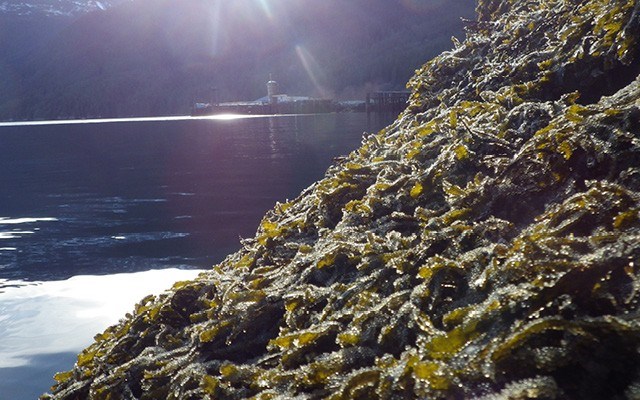Local conservationists are warning of the potentially "huge" impact on Howe Sound's vital herring population if a marine intake pipe at the Woodfibre LNG site is installed too close to spawning fish.
Fisheries and Oceans Canada (DFO) recommends that any marine water intake pipe, commonly used at industrial plants for cooling, be located at least two kilometres outside of documented herring spawning zones.
Local conservationist John Buchanan, who has been surveying herring in the sound for six years, claims to have found spawning herring within 60 metres of the Woodfibre site.
"There are kilometres of spawn but it always centralizes around the Woodfibre area," he said.
According to the federal guidelines, these marine intakes can have "severe impacts on marine resources," citing herring eggs and larvae as being especially vulnerable.
The proposed intake pipe at Woodfibre, which would draw roughly 17,000 cubic metres of water per hour from the sound, is being considered for a possible location just north of Mill Creek, although the company is awaiting the results of its own herring surveys before confirming a possible site for the pipe.
"We noticed in the DFO guidelines that two kilometres is a recommendation, and we don't take that recommendation lightly and understand that it is a best practice, but right now we want to make sure and wait until the outcome of these studies to understand exactly where those spawning locations are, and then we can figure out the exact distance," explained Nathan Gloag, Woodfibre LNG's balance of plant manager. The results of those surveys are expected this month.
Gloag said divers have located herring in the area Woodfibre has surveyed, located along the foreshore and directly in front of the proposed plant, and, when pressed, could not promise the planned pipe would fall outside of the recommended two-kilometre zone.
"I won't guarantee that," he said. "The key there is we have to wait for the outcome of the studies because I can't really speculate today without fully understanding what the results are. But once we understand exactly what these results are, then we will determine if we will have to impose additional mitigation measures or not to make sure that we minimize the impact as best as possible where that intake is positioned."
Herring, in particular, are essential to the area's marine ecosystem as a food source for many other aquatic species, explained Stan Proboszcz, biologist with Propeller Strategy.
"Herring are really important to the marine food web," he said. "Many people have been saying that one of the reasons we've seen all these mammals come back to the sound is because the herring population is coming back."
The recent resurgence of herring in the sound can be linked in part to the closing of the Woodfibre pulp mill in 2006, Buchanan believes.
"That is really the smoking gun," he said. "We've gotten rid of the Woodfibre effluent (from the pulp mill) and now we're going to put something else right back in the middle of it? It's just incredible that they would actually install something like that when the DFO's own regulations don't (recommend it)."
Proboszcz is worried about the potentially "huge impact" the cooling system could have on the herring population in light of fish populations in Europe that have been devastated by marine intake pipes at other LNG plants.
"I did look at some examples of this type of cooling system in other parts of the world, and there are some plants in Europe where they've monitored and shown that hundreds of thousands of fish can be killed over a year or so," he said.
An alternative suggested by Proboscz that would be less impactful to marine life is using an air-cooling system, which was considered by Woodfibre.
"We looked at a number of different alternatives during our preliminary design, such as air cooling and others, and we came back to seawater cooling for a number of reasons: Because it has less footprint at the project site; less environmental noise impact; less visual impact when compared to air cooling; and because it's such a constant cooling medium throughout the entire year," Gloag noted.
With the number of LNG plants proposed for B.C., Proboscz also thinks it's high time the federal government update its guidelines around limiting the loss of animals to marine intakes. The current guidelines were passed in 1991.
"There needs to be a review of the science around these guidelines, and I think we need to move forward in a precautionary way and perhaps update the science that's available before we move forward with these plants that may put one of the most important species in our marine oceans at risk," he said.
Fisheries and Oceans Canada was not available for comment at press time.




